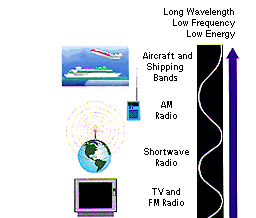


A disturbance that can travel
through a vacuum as well as through a material medium, light and radio waves
being familiar forms. It consists of oscillating (time-varying) electric and
magnetic fields with directions at right angles to each other and to the
direction of propagation. The two fields are bound together, the time-varying
electric and magnetic components regenerating each other in an endless cycle
that moves from one point to the next through space. The radiation transfers
energy and also momentum. It travels through a vacuum at the speed of light,
c, which is of 299,792.58kms-1 (186,201 miles/s). The speed is
slightly reduced on entering a medium, such as air, glass or water.
Electromagnetic radiation is caused by the acceleration of charged particles,
such as electrons. Its propagation through space can be fully described in terms
of wave motion. Like other periodic waves, electromagnetic waves have a
wavelength l and a frequency v, which are related by lv = c.
Reflection, refraction, interference, and polarization can be explained in terms
of wave motion. When radiation interacts with matter, however, it exhibits
particle-like behaviour, as when it undergoes absorption or emission. It thus
has a dual wave-particular nature. A particle nature was originally proposed by
Newton but in its present form the concept is part of quantum theory. Light and
other kinds of radiation interact with matter as quanta. A quantum of radiation
of frequency v transfers energy hv and moment hv/c2,
where h is Planck constant. The quantum of electromagnetic radiation is
the photon. Light, etc., is thus absorbed by or emitted from atoms or molecules
in the form of photons.
The range of frequences ( or wavelengths) of electromagnetic radiation is known
as the electromagnetic spectrum. The spectrum can be divided into various
regions range from low-frequency low-energy radio waves through infrared
radiation, light (Violet l = 3.9x10-7m and Red l = 7.8x10-7m),
ultraviolet radiation, X-rays, to high-frequency high-energy gamma rays.
Can travel through empty space
| Speed of light is constant in space. All forms of light have same speed in
space.
| Wavelength of light defined similarly to that of water waves - distance
between crests or troughs. | |
If P is the energy passing through this unit area in joules per second,
i.e., if P is power in watts, then we say that P is the wave
intensity in Wm-2.
If the distance is increased to 2m it is clear from the geometry of the figure
that the same power is now spread over an area of 22 = 4m2.
Consequently the wave intensity is reduced to ![]() .
Similarly, when the distance is increased to 3m the wave intensity in Wm-2 is
now only
.
Similarly, when the distance is increased to 3m the wave intensity in Wm-2 is
now only ![]() .
.
Wave intensity is defined as the power transmitted per
unit area of the wavefront.
In general, the wave
intensity at any distance x from a point source is given by ![]() .
.
This relationship
between wave intensity and distance is expressed by the inverse square law.
The electromagnetic wave intensity from one point source in free space is inversely proportional to the square of the distance from the source.
Light as a special case. The measurement of light wave energy
(photometry) is complicated by the fact that light sources contain non-visible
radiation as well, example ultraviolet (UV) and infrared (IR). Special units
called lux (not Wm-2) therefore have to be used, but all the same,
the inverse law still holds.

The distribution of this phenomena is obtained when electromagnetic radiation is absorbed or emitted. Well-known examples of this phenomena are when a white light passes through a prism or the rainbow. This effect is also obtained when white light passes through a diffraction grating, which produces a continuous spectrum, in which all wave-lengths (between certain limits) are present.
| Type of Radiation | Frequency Range (Hz) | Wave-length (l) Range | Type of Transition | |||||||||||||
| radio waves
|
< 3x1011 | > 1mm | nuclear spin flips* |  |
||||||||||||
| microwaves | 3x1011 - 1013 | 1mm-25µm | molecular rotations, electron spin flips * |  |
||||||||||||
|
|
|
|
 |
||||||||||||
| x-rays | 1017 - 1020 | 1nm-1pm | inner electron | |||||||||||||
| gamma-rays | 1020 - 1024 | <10-12m | nuclear |  |
*energy levels split by a magnetic field.

In 1931 in the United States, Karl Jansky (1905-50), a radio engineer, had discovered the radio waves from space. This discovery happened when he was investigating the nature of static, when he found that he was picking up emissions from the sky. He tracked them down to the Milky Way. He published few papers, but never followed the subject through. Another American, G. Reber, before the World War II, had setup a dish-shaped radio telescope and made the first radio map of the Milky Way. A British team led by J.S. Hey, during the war, found that the radars where not jammed by transmittions from Germany, as it was previously thought, but by radio waves from the Sun.
Subsequently, radio telescopes were set up and a new branch of science was well
under way. The Earth is close to the Sun and for this it is obtrusive, since the
Sun is a radio source but cosmic standards not a powerful one. Even Jupiter is
known as to be a source of radio waves. But most radio sources lie far beyond
the Solar System. Those in our Galaxy include many supernova remnants, of which
the Crab Nebula is the most celebrated example. There are many radio galaxies at
greater distances, which are extremely power at long length still not known.
Radio astronomy had help us to tremendously to increase our knowledge of the
universe. Nothing or almost nothing would have been known about pulsars, which
are neutron stars, or quasars, which are extragalatic and may well be the most
powerful objects known to man, without it. More over, radio waves have been
studied for more time from the visible light waves, so that our information
about most distinct regions of the universe is derived entirely from radio work.
The infrared lights are absorbed by the upper atmosphere and are studied by a special equipment carried by satellites. However, some of it passes through some hole in the atmosphere and therefore, they can be studied from ground. This branch of research was useful to increase our knowledge about stellar evolution. Infrared is also produced by extremely young stars, such as the variable V1057 in Cygnus, which when the dust, contained in the clouds surrounding the star, is heated. The Brecklin's Object inside the Orion Nebula is an example of some objects that are detectable only by infrared techniques.
Even these rays are absorbed by the upper atmosphere. To study high-energy Ultraviolets, x-rays and gamma-rays (that is, radiations below 2,900A) a special equipment, carried by a satellite or a rocket, must be used.
Copernicus and the International Ultraviolet Explorer, satellites, have studied
radiation from the rare very hot stars - at temperatures of 30,000°C (54,000°F
or 30,273K) or more. The gas clouds encountered, and passed through, by the
ultraviolet light effect it and proportions of differnt chemical elements in the
gas in space where revealed in detail.
X-ray astronomy satellites, like Uhuru (launched in 1970), HEAD-1 and the
Einstein Observatory(1978-81), have detected many powerful x-ray sources. One
member, of the double stars in our galaxy, is a very compact neutron star, which
is pulling gases off its ordinary companion: the hot gas steam emits x-rays
copiously.
The first pictures of x-ray sources where taken by the sophisticated Einstein
Observatory. These pictures revealed the distribution of extremely hot x-ray
emitting gas in the remains of exploded stars, and between the galaxies in very
distant clusters of galaxies. Giant gas clouds in our galaxy emit gamma-
radiation, this was found by the Gamma-ray Observatories. Short bursts of
gamma-rays from space, where discovered by gamma-ray satellites launched for
military surveillance of the Earth.
![]()